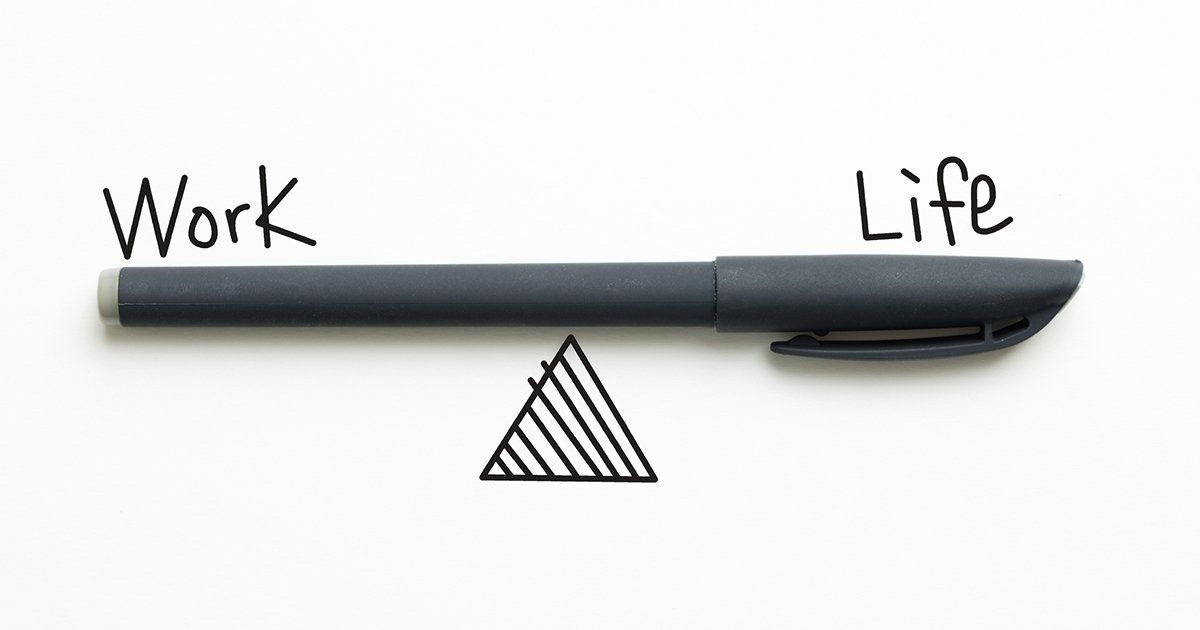How Managers Can Facilitate Better Work-Life Balance

In any industry, the importance of a work life balance is crucial to increasing productivity on the clock while making time for mental health checks outside of work. A poor work life balance can be detrimental to efficiency at work. In fields where you need to give your full attention to work-related responsibilities, like healthcare, not being fully present while working can be harmful and even dangerous to patients.
As new, innovative ways to create a work life balance are discovered worldwide, there are a multitude of different ways for you and your team to unwind.
What Is a Work Life Balance?
A work life balance is the term used to describe a healthy separation of job title and personal life and is crucial for the important mental and physical recovery of unwinding after work. For example, for care providers in a mental health facility, leaving certain items like uniforms or badges in a safe place outside of the home, such as a locker at work, may be a way to help create a more distinct difference between work life and home life, which is part of developing a healthy work life balance.
Most people believe they separate their personal life from their work life. They take off their work clothes, engage with family, and unwind. However, it’s sometimes hard to disentangle emotional complications from work once you make it home. Though it can be difficult, maintaining a healthy separation of work obligations and home life is a crucial part of positive mental health.
As with any mental health strategy, how any individual creates a healthy work life balance can change from person to person. If you are an HR manager working to improve the mental health of your team, it makes sense to employ more than one strategy.
Finding the best solution for a team may be as simple as creating a space for employees to leave their work items while not at work, or it can be more complex with a communication schedule that creates a “no contact” time window each night. Each system will take time to naturalize, but in the end, the benefits of introducing ways to promote a work life balance for staff are bound to help improve staff productivity and attentiveness at work.
Why Is a Work Life Balance Important?
As the working world continues to change, how we approach the idea of work has changed as well. For example, rather than the traditional Monday through Friday, 9-5 grind, lots of companies are utilizing shorter work days or shorter work weeks to decrease burnout and alleviate extra stress faced by employees.
Other companies are transforming schedules altogether, something that can be done now in the era of remote work. If an employee is better focused at night, arranging a schedule from home where they are most productive can hugely impact both their work-life balance and their productivity.
Studies have shown that reducing the number of hours an employee is expected to work without a reduction in pay leads to higher productivity rates. By getting rid of the expectation of a full eight-hour workday, employees can focus on more important tasks during their working hours. More downtime outside of work, as well as more time away from work-related obligations, allows for employees to recover after these shifts properly.
It may seem counterproductive to increase downtime outside of work as a way to increase productivity at work; however, by giving employees the mental and emotional space to recover after their shifts, they will inevitably feel refreshed and prepared to take on their next shift. In industries that are mentally, physically, and emotionally charged, like those working in behavioral health centers, this time outside of work to decompress and unload after a stressful day is important for maintaining any semblance of a work life balance.
That being said, incorporating different standards, communication, and rules into workplace routines requires dedication from the top down. The managerial team has to be able to implement such variations in schedules both equitably and in such a way that it doesn’t impact the business.
Reasons for Imbalance in Work Life Balance

Every individual is different, and everybody’s commitment to their work schedule is different as well. For some, the thought of leaving work early or undone can be stressful, whereas others, usually those with a better work life balance, can handle pushing back deadlines or only working for the amount of time it takes them to complete a certain task. Depending on different attitudes towards work, personal life, or team interactions, current workplace routines might be contributing to the poor work life balance of staff.
Some of the most common factors that throw off a healthy work life balance can include:
Perfectionism
For some people, finishing a task and completely diving into their work duties is crucial to feeling accomplished. Completely throwing oneself into work or limiting break time due to a feeling of needing to get back to work can throw off or eliminate a work life balance. The quest for perfectionism and the expectation of perfectionism with no room for growth is detrimental to team functionality, causing a healthy work life balance to suffer as a consequence. For example, if the current daily expectation for staff is to sell a certain number of products, but day-to-day sales records are still below that quota, even on peak sale days, readjusting team goals can be a great way to lessen stress in the workplace.
Lack of Self Care
Although self care is sometimes viewed as a luxury, taking personal time outside of the workday is important for recovery and mental clarity. Ranging from skincare and exercise routines to therapist sessions and evening meals on the town, self care encompasses a wide category of activities that can help relieve stress and promote improved mental health or some much-needed relaxation after work.
Without the necessary time allotted for self care or by avoiding any self care activities outright, this lack of downtime can throw off a functioning work life balance by repressing that stress accumulated at work. Stress relief is inherently linked to self care, and bringing home the stress of the workplace can only make those negative feelings multiply and blur the lines between work and home.
Lack of Boundaries
Depending on the job field, as well as what teams and activities employees are responsible for, work-related messages may come in at all hours, which can interrupt anyone’s personal life. Setting crucial communication boundaries within a team can help limit the number of conversations held with employees after hours or away from work, helping establish a healthy work life balance.
Work Life Balance Problems and Solutions
As with many mental health-related systems, taking the time to fix and adjust any routines that have been thrown out of order takes some hard work. Taking the time to establish new routines is an investment, but it’s worth it. Some workplaces may benefit from a large-scale overhaul of current operating procedures, whereas others might be better off with smaller changes that can be accomplished within a day. Finding the right solution for a poor work life balance may include some trial and error; however, this learning period is crucial to helping find a plan that works for all employees.
Here are some of the most effective and common ways to help encourage a healthy work life balance for management and staff alike:
Delegate Tasks
One of the biggest stressors faced by management is separating management from leadership. The responsibility to uphold and enforce all business standards, ranging from cleanliness to training opportunities, can be stressful and exhaustive. Finding a way to delineate tasks to a team, either by assigning them roles or fixed positions, can help lessen the amount of stress faced while at work.
For tiered management systems, where there is an intermediate level of management between upper management and staff, delineating tasks like cash handling that need to be performed with a certain level of responsibility may be a possible solution to lessening the responsibility load entrusted to a member of a workplace’s management team.
Unplug

Obviously, you can’t tell your team to unplug from work when they get home, but you can tell them they can disconnect from work completely. Taking the time to unplug and separate downtime from work time can help calibrate a work life balance. Technology in the workplace has been extremely beneficial for creating a reliable, easy-to-use form of communication between management and employees.
On the other hand, this increase in accessibility can lead to unwanted, even bothersome, communications outside of work that make getting away from work seem impossible. For some, unplugging can take the form of leaving work-related electronics off during non-working hours, and for others, this can be responding to text messages or communication requests by rescheduling a time to talk during work hours.
Take breaks and Time Off
As mentioned previously, the importance of self-care is crucial for creating a proper work life balance – and that’s true for management, their teams, and executives. Taking much-needed time away from work and away from any stressors created at the workplace can help mentally prepare for a return to work. Self-care utilizes free time out of work to unwind and take some of the stress from working off of your shoulders, and the same goes for employees.
Encouraging self care-oriented behaviors for staff can help them create a healthy work life balance, and integrating more opportunities to utilize these self care tools throughout the workday can help rebalance a poor work life balance as well. Self care luxuries, like massages, pedicures, or other such treatments, can be great incentives for work. Using such gift cards as bonuses can boost morale, improve self care, and increase workplace productivity.
Work Life Balance Examples
The different methods of reinstating or fixing a work life balance begin with one key factor: time. Recognizing the time for certain tasks, either regarding self care or work time, is the first step in figuring out how to begin a work life balance restructuring. Simple changes like conversations with staff members or frequent check-ins to get to know employees as a way to encourage them to start taking more opportunities to restructure their work life balance can be helpful in figuring out what specific strategies are functional for the workplace.
Communication Safety Zones
Creating a system that encourages boundaries relating to communication between management and employees is a great way to restate and reaffirm a work life balance. Emergencies do happen, and outside of these emergency circumstances, reassuring team members that work-related communication ends at a specific time can help not only reinforce communication boundaries but can also help employees feel like their time is respected as well. Reciprocating a scheduled communication block is a great way to help employees create a better sense of management availability, allowing them to create their availability that reinforces their work life balance as well.
Separating Work and Home Items
This may seem somewhat odd, but creating a designated spot for work-related items can be beneficial in creating a work life balance. Providing break rooms, lockers, or areas of the workplace that can host these items can help team members mentally separate their home life and their work life. For example, in some occupations, a workplace uniform or certain style of clothing like scrubs is necessary for completing the job.
Offering employees a room or area to change into their work clothes and store their out-of-work clothes during their shift can help create mental separation between what they wear on the clock and what they wear outside of work. Most importantly, when they change out of their gear or uniform, they can start the process of feeling more connected to home.
Leaders Should Value the Importance of a Work Life Balance

As a manager, being responsible for your team is one of the biggest roles you play. Knowing when to step back and put your work life on hold is crucial for your mental and physical health – and it helps you respond to your team in more productive ways. Finding the right work life balance may be hard at first, but once you figure out what works, the results will be amazing for your own mental and physical health, as well as that of your team members.
Overall, the scope of what constitutes a proper work life balance is up to the individual, but by offering opportunities and leading by example, you can help your team make healthier choices and provide a more productive work environment.















